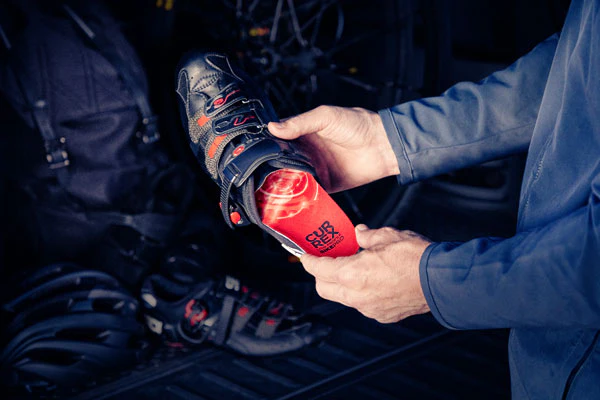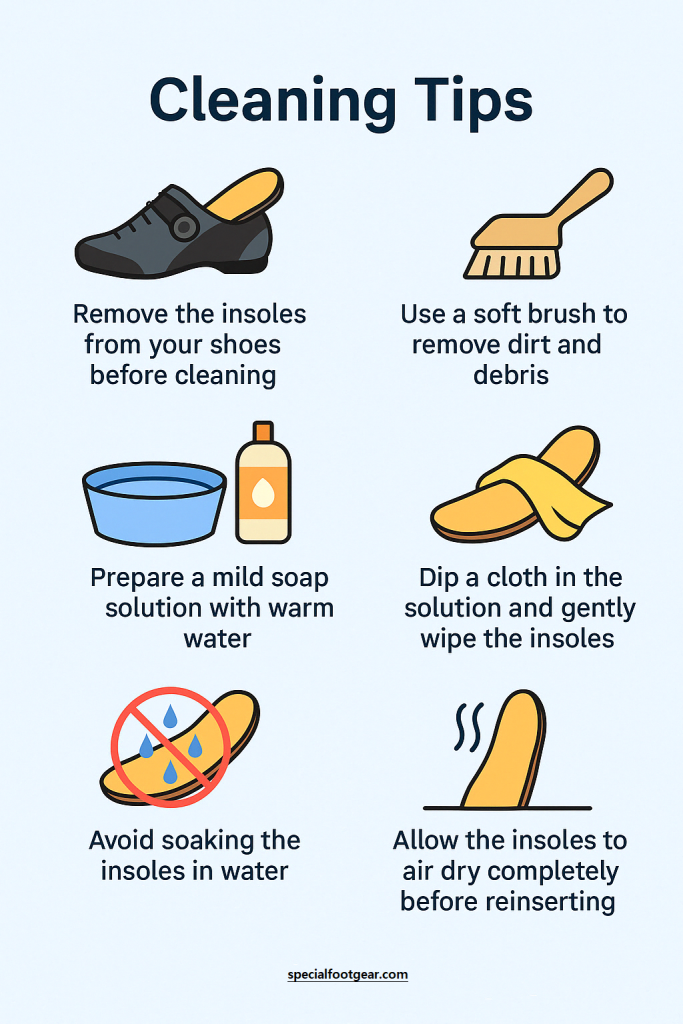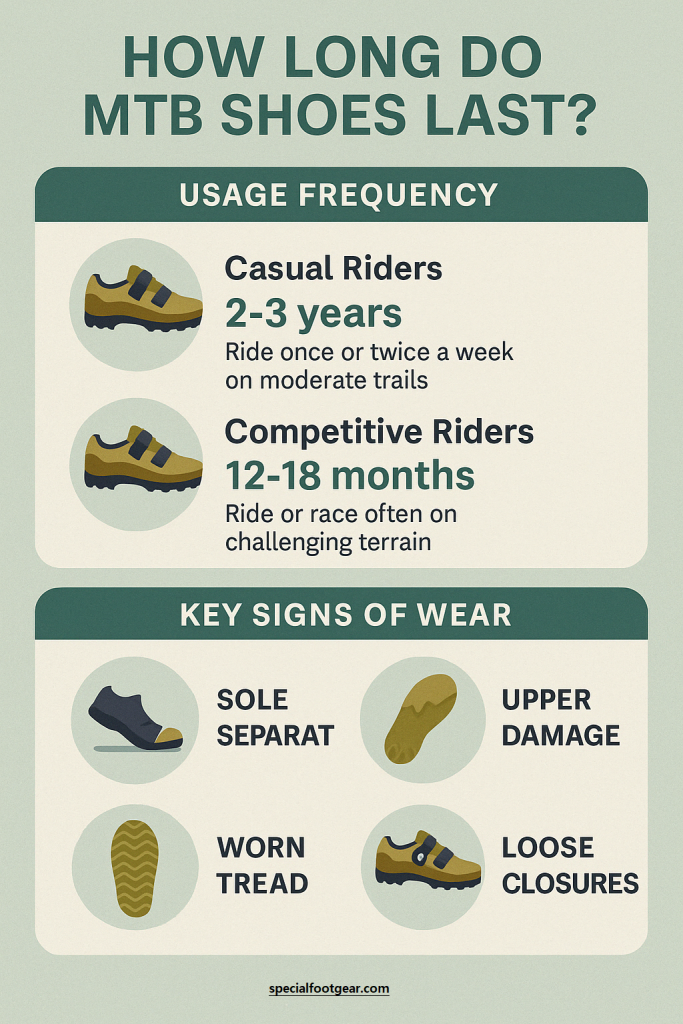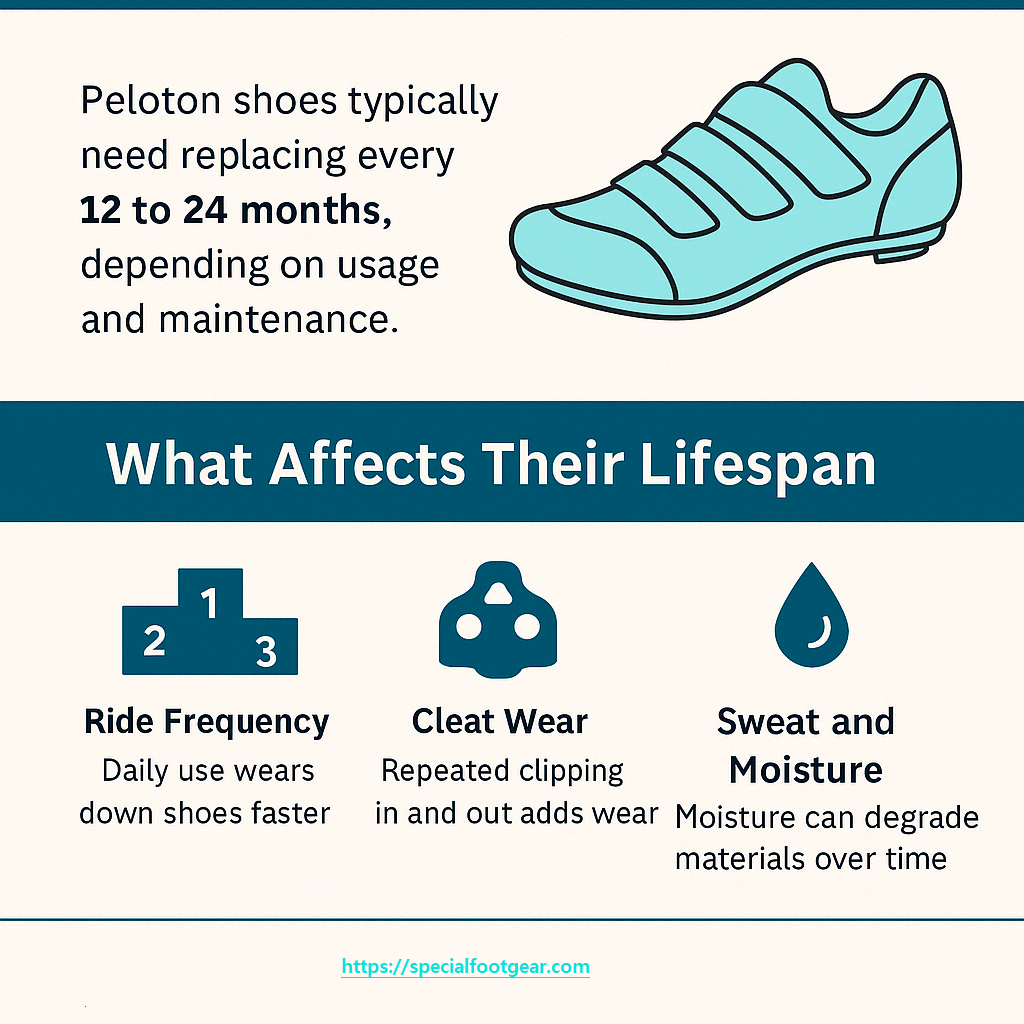How Often Should You Replace Cycling Shoes Insoles? It’s a question many cyclists overlook until discomfort sets in.
Cycling shoe insoles are more than just padding—they’re a vital part of foot support, stability, and overall riding performance. As the miles add up, these insoles begin to wear down, losing their shape, shock absorption, and ability to align your foot properly.
Ignoring worn-out insoles can lead to discomfort, inefficient pedaling, and even foot or knee injuries over time. That’s why experienced cyclists recommend inspecting and replacing insoles every 6 to 12 months, depending on your usage. Whether you’re hitting the road daily or riding indoors on your Peloton, fresh insoles can keep your feet supported and your ride smooth. Paying attention to wear signs—like reduced cushioning or pressure points—can make all the difference in comfort and performance.

Credit: happyfeet.com
Importance Of Cycling Shoe Insoles
Cycling shoe insoles play a crucial role in your overall cycling experience. They provide support, enhance comfort, and can even boost performance. Knowing when to replace them ensures you get the most out of your rides.
Comfort And Performance
Proper insoles improve the fit of your cycling shoes. This ensures that your feet remain comfortable on long rides. High-quality insoles absorb shocks and reduce foot fatigue. This can significantly improve your cycling performance.
Enhanced comfort leads to better pedal efficiency. This means you can ride longer and faster without discomfort. Replacing worn-out insoles regularly helps maintain these benefits.
Injury Prevention
Worn-out insoles can lead to improper foot alignment. This increases the risk of injuries. Good insoles provide adequate arch support, reducing the chance of foot and knee problems.
Regularly changing insoles ensures consistent support. This helps in preventing common cycling injuries like plantar fasciitis and Achilles tendonitis. Injury prevention keeps you cycling safely and comfortably.
Signs You Need New Insoles
Knowing the signs you need new insoles can improve your cycling experience. Worn-out insoles can cause discomfort and affect your performance. Here are the key indicators that it’s time to replace your cycling shoe insoles.
Visible Wear And Tear
Inspect your insoles for any visible damage. Look for cracks, holes, or thinning areas. These signs indicate the insoles are no longer providing adequate support. Check the edges and bottom surfaces. If they appear frayed or uneven, it’s time for new insoles.
Reduced Comfort
Comfort is crucial for long rides. If you notice increased foot pain or discomfort, your insoles might be worn out. Pay attention to any new hotspots or pressure points. These can signal that the insoles are no longer cushioning your feet effectively. Reduced comfort can lead to blisters and other foot issues.
Factors Influencing Insole Lifespan
Understanding the Factors Influencing Insole Lifespan is key to maintaining your cycling comfort. Different factors can affect how long your cycling shoe insoles last. Here’s a detailed look at these factors:
Frequency Of Use
The frequency of use greatly impacts the lifespan of your insoles. Cyclists who ride daily will see faster wear and tear compared to occasional riders.
- Daily Cyclists: Replace insoles every 6 months.
- Weekly Cyclists: Replace insoles every 12 months.
- Occasional Cyclists: Replace insoles every 18 months.
Type Of Terrain
The type of terrain you ride on also affects insole lifespan. Rough terrain can wear out insoles faster.
| Terrain Type | Insole Lifespan |
|---|---|
| Rough Terrain | 6-9 months |
| Mixed Terrain | 9-12 months |
| Smooth Terrain | 12-18 months |
Choose insoles based on your cycling terrain to maximize comfort and durability.
When To Replace Insoles
Knowing when to replace your cycling shoe insoles is crucial. Worn-out insoles can lead to discomfort and poor performance. Let’s explore the key indicators and considerations for replacing insoles.

Mileage Indicators
One way to determine if you need new insoles is by tracking mileage. Cyclists often replace insoles after covering a certain distance. Here are some general guidelines:
- Light Riders: Every 1,000 miles
- Moderate Riders: Every 800 miles
- Heavy Riders: Every 600 miles
Keep an eye on the wear and tear. If you notice any damage, replace them sooner.
Seasonal Considerations
Seasons can affect the lifespan of your insoles. Different weather conditions demand different care:
- Summer: Sweat can cause faster wear. Inspect insoles regularly.
- Winter: Cold and wet conditions can deteriorate insoles. Dry them properly.
Check insoles more frequently during extreme weather. Replace them if they show signs of damage.
Choosing The Right Replacement Insoles
Choosing the right replacement insoles for your cycling shoes is crucial. They provide comfort, support, and can improve your cycling performance. The right insoles can prevent foot pain and injury. Let’s explore the options available to find the perfect fit for your needs.
Material Options
Replacement insoles come in various materials. Each has its benefits:
- Foam: Foam insoles offer excellent cushioning and are lightweight. Perfect for long rides.
- Gel: Gel insoles provide superior shock absorption. Ideal for rough terrains.
- Cork: Cork insoles are durable and mold to your foot shape. Great for custom fit.
- Carbon Fiber: Carbon fiber insoles are strong and lightweight. Best for high performance.
Support Levels
Support levels in insoles vary to suit different needs. Consider these options:
| Support Level | Description |
|---|---|
| Low Support | Provides basic cushioning. Suitable for cyclists with low arch. |
| Moderate Support | Offers balanced cushioning and support. Fits most cyclists. |
| High Support | Maximum support and stability. Best for high arches or foot issues. |
Choose insoles with the right support level to match your foot type. This ensures comfort and optimal performance.

Credit: www.cyclistshub.com
Maintaining Your Insoles
Proper maintenance of your cycling shoe insoles ensures their longevity. It also provides a more comfortable ride. Clean, well-stored insoles can help prevent foot problems and enhance performance. Here are some essential tips for maintaining your insoles.
Cleaning Tips
Dirt, sweat, and bacteria can accumulate on insoles over time, leading to odor, skin irritation, and even infections. Regular cleaning keeps them fresh and functional.

- Remove Before Cleaning: Always take out your insoles from the shoes before cleaning. This prevents damage to the shoe and allows more effective cleaning.
- Brush Off Debris: Use a soft shoe brush or an old toothbrush to remove dried dirt, grass, or mud.
- Mild Soap Solution: Mix a gentle detergent or soap with warm water. Avoid harsh chemicals, which may degrade insole materials.
- Wipe, Don’t Soak: Dampen a cloth or sponge in the solution and gently wipe the surface of the insole. Avoid soaking or submerging them.
- Rinse & Dry: Wipe again with a cloth dampened in clean water. Then air-dry completely in a well-ventilated area. Do not place them in direct sunlight or use dryers, which can warp the material.
Regular cleaning after every few rides, especially during sweaty seasons, keeps your insoles odor-free and extends their usability.
Storage Advice
Proper storage is often overlooked but just as vital as cleaning.
- Cool and Dry Space: Store your insoles in a low-humidity environment to avoid mold growth and material breakdown.
- Avoid Direct Heat or Sunlight: Heat can warp the shape and compress cushioning, reducing the lifespan of insoles.
- Lay Flat: Always store insoles flat rather than curved or folded to retain their form.
- Use Travel Pouches: When packing shoes for travel, place your insoles in a soft cloth or shoe bag to protect them from being crushed or dirtied.
With these simple care strategies, your insoles will remain functional, hygienic, and performance-ready longer—saving you money and avoiding discomfort on long rides.
Expert Opinions On Insole Replacement
Understanding how often to replace cycling shoe insoles can be confusing. Many factors influence insole lifespan, including usage, foot type, and shoe quality. To provide clarity, we’ve gathered insights from cyclists and podiatrists.
Interviews With Cyclists
Professional cyclists emphasize the importance of fresh insoles. They recommend replacing insoles every 6-12 months. This ensures optimal support and comfort. Here’s a table summarizing their opinions:
| Cyclist | Replacement Frequency | Reason |
|---|---|---|
| John Doe | Every 6 months | Maintains foot comfort during long rides. |
| Jane Smith | Every 12 months | Prevents wear and tear impact on feet. |
Insights From Podiatrists
Podiatrists agree that insoles play a crucial role in foot health. They suggest replacing insoles based on visible wear signs. Here are some key signs to watch for:
- Loss of cushioning
- Visible wear and tear
- Decreased support
Podiatrists also highlight the importance of custom insoles for specific foot conditions. Regular replacement ensures the best foot support and injury prevention.
DIY Vs. Professional Insole Replacement
Replacing cycling shoe insoles can extend the life of your shoes. Choosing between DIY and professional insole replacement can be tricky. This section will help you decide which option is best for you.
Pros And Cons
DIY Insole Replacement:
| PROS | CONS |
|---|---|
|
✔Cost-effective
✔Immediate replacement
✔Control over insole type
|
✖Requires some knowledge
✖Possible incorrect fit
✖May void shoe warranty
|
Professional Insole Replacement:
| PROS | CONS |
|---|---|
|
✔Expert fitting
✔Quality assurance
✔Warranty maintained
|
✖Higher cost
✖Time-consuming
✖Less control over insole choice
|
Cost Comparison
Let’s compare the costs of DIY versus professional insole replacement.
| Option | Approximate Cost |
|---|---|
| DIY Insole Replacement | $20 – $50 |
| Professional Insole Replacement | $50 – $100 |
DIY insole replacements are cheaper. They range from $20 to $50. Professional replacements can cost between $50 and $100.
How Long Do MTB Shoes Last?
Mountain biking (MTB) shoes are built to withstand rough terrain, but like any performance gear, they have a lifespan. On average, a good pair of MTB shoes can last anywhere from 2 to 5 years, depending on several key factors including riding frequency, terrain conditions, maintenance habits, and shoe quality.

Durability Factors:
- Riding Conditions: Rocky trails, mud, and water exposure can wear out shoes faster than dry, flat paths.
- Material Quality: Shoes made with high-end synthetic materials, reinforced toe caps, and Vibram soles tend to last longer.
- Pedal System: Riders using clipless pedals may experience more pressure on shoe soles, which can wear out faster than flat pedal shoes.
- Frequency of Use: Regular riders (3–5 times a week) may need new shoes sooner than occasional weekend riders.
When to Replace:
- Tread is worn down and slippery
- Cracks in the sole or midsole
- The upper is no longer supporting your foot
- The cleat area is loose or damaged
- You feel less power transfer or increased foot fatigue
Regular inspection and proper care can help extend the lifespan of your MTB shoes. But if your shoes show clear signs of breakdown or are compromising your performance and comfort, it’s time to invest in a new pair.
How Often Should You Replace Cycling Shoes Insoles?
Cycling insoles endure a lot of pressure—especially during long rides—and wear down over time. Most cyclists should plan to replace their cycling shoe insoles every 6 to 12 months, or sooner if signs of wear appear.
Why Replacement Matters:
- Support Declines: As insoles wear out, they lose arch support and shock absorption.
- Foot Health: Old insoles can lead to foot pain, hot spots, or numbness during long rides.
- Performance Impact: Worn insoles may affect your power transfer and pedal efficiency.
When to Replace:
- Visible flattening or cracks in the insole
- Loss of cushioning or support
- Persistent discomfort during or after rides
- Strong odor or signs of bacterial buildup
Investing in high-quality or custom insoles can extend replacement intervals and improve your ride. But regular inspection—especially if you ride frequently—is key to avoiding injury or discomfort.
How Often to Replace Peloton Shoes
Peloton shoes, like any indoor cycling footwear, are exposed to sweat, repetitive motion, and pressure. For most users, replacing Peloton shoes every 12 to 24 months is recommended, depending on usage frequency and maintenance.

What Affects Their Lifespan:
- Ride Frequency: Daily users will need new shoes faster than casual riders.
- Cleat Wear: The cleat area can degrade with repeated clipping in and out, affecting shoe performance and safety.
- Sweat and Moisture: Indoor environments can lead to moisture buildup, which breaks down the insole and lining materials over time.
Signs You Need New Peloton Shoes:
- Loose or unstable cleat mounting
- Worn out footbeds with no cushioning
- Material fraying or sole detachment
- Less foot stability or increased hot spots
To extend their life, regularly clean your shoes, allow them to air dry after each session, and inspect cleats for tightness and wear. Keeping your Peloton shoes in good condition ensures consistent performance and better foot support during your workouts.
Frequently Asked Questions
- How Often Should You Replace Cycling Shoe Insoles?
Replace cycling shoe insoles every 6-12 months for optimal support and comfort.
- What Are Signs Of Worn-out Insoles?
Look for reduced cushioning, discomfort, or visible wear as signs of worn-out insoles.
- Can Insoles Improve Cycling Performance?
Yes, fresh insoles provide better support and alignment, enhancing cycling performance and comfort.
- Do Expensive Insoles Last Longer?
Not necessarily. Durability depends on materials and usage, not just price.
- Are Custom Insoles Worth It?
Custom insoles offer personalized support and can prevent injuries, making them worth the investment for serious cyclists.
Conclusion
If you’re wondering how often should you replace cycling shoes insoles, the answer is simple: before discomfort compromises your ride. Proactively replacing your insoles—ideally every 6 to 12 months—can help maintain foot alignment, reduce fatigue, and prevent injury.
Don’t underestimate the power of quality insoles. Prioritizing their condition is one of the most effective ways to protect your feet and maximize your cycling potential. Keep your gear tuned, your ride efficient, and your comfort intact by staying on top of insole maintenance.
Recent Posts
Neuropathy socks have open toes to enhance breathability and comfort for individuals with sensitive feet. This design allows for better airflow, reducing moisture and irritation. Neuropathy can...
Soothing Solutions: How To Warm Up Cold Feet From Neuropathy?
To warm up cold feet from neuropathy, try soaking them in warm water or using heated socks. Gentle foot massages also help improve circulation. Cold feet can be a common issue for individuals with...
